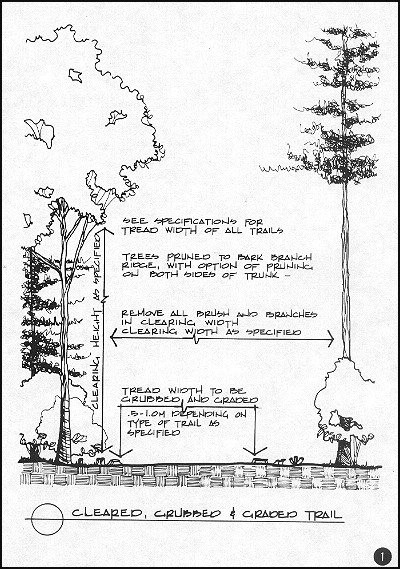7.4 Clear the
Route
-
Match the trail clearing and tread width to the type of trail.
-
Stake the trail route from start to finish. Stake the centre-line for minimum
standard trails and both sides of the trail for higher standard trails.
Place the stakes to define the trailbed and clearing limits.
-
Before full excavation and construction take place, clear and excavate
a narrow work path from the outside stake towards the centre-line. This
path establishes the grade and excavation line for the rest of the trailbed.
If alterations are needed, less time and damage is done than if the entire
trail width is graded.
-
Clear vegetation to provide safe and unimpaired movement along the a-ail.
Remove adjacent shrubs and small trees that will quickly grow back into
the right-of-way. Remove branches that will obstruct travel. Clear branches
to a height of 2.5 m on hiking and bicycling trails, higher for winter
use, or horse trails.
-
Cut stumps flush with the ground. Cut branches flush with tree trunks.
Cut branches all around the trunk to minimize the aesthetic impact.
-
Remove ground cover plants, trees and shrubs that cannot be bypassed. Leave
rocks in place unless they are numerous enough to be a hazard or hindrance.
On bicycle trails and ski trails remove all large rocks and obstructions.
-
Cut small exposed roots back to the trail edge to prevent sucker growth
through the trail surface. Avoid cutting large tree roots that might result
in a windfall hazard.
-
Remove large branches by sawing in three places to prevent tearing the
bark.
-
Avoid cutting terminal buds on small trees next to the trail as this promotes
lateral growth.
-
Remove windfalls or cut wide sections through the trunk. On sideslope trails
the upper cut should be 30 cm back from the top of the embankment. Beware
of windfalls on slopes as the upper section may be hazardous if cut free.
-
Remove all dangerous trees and snags that may fall onto the trail.
-
Consider using selected logs and branches from clearing operations to help
build up the trail tread. This is suitable for Type III or IV hiking trails
but not for uses where a very firm or even surface is required, e.g. for
bicycle or equestrian trails, or trails where service vehicles will be
used.
Figure 5: Cleared, Grubbed and Graded Trail

|

